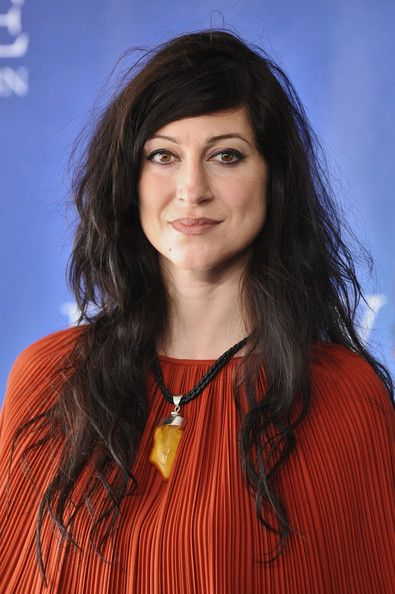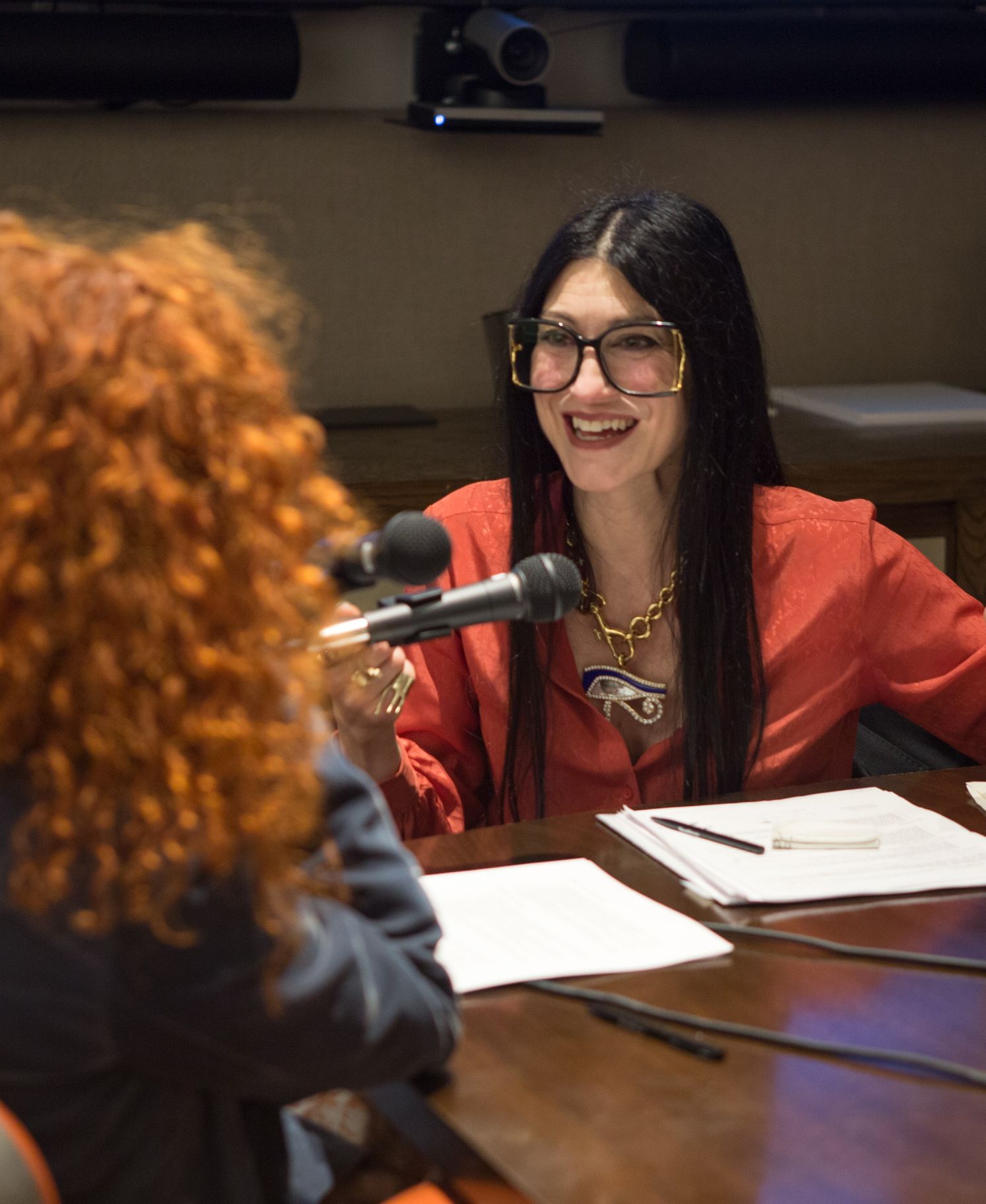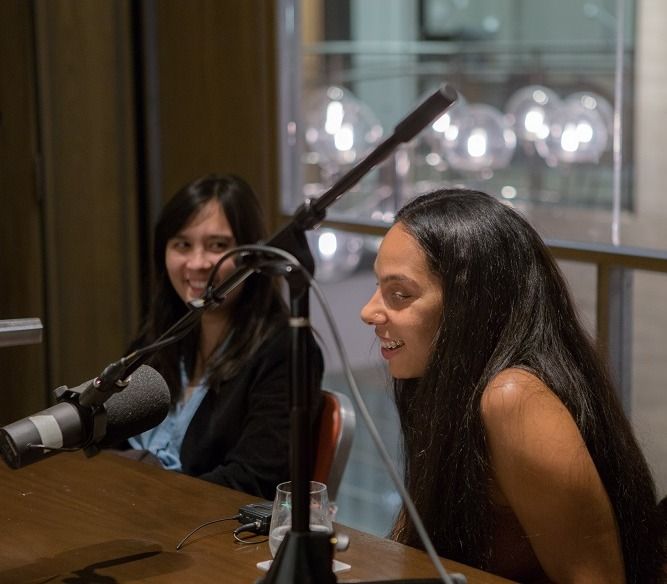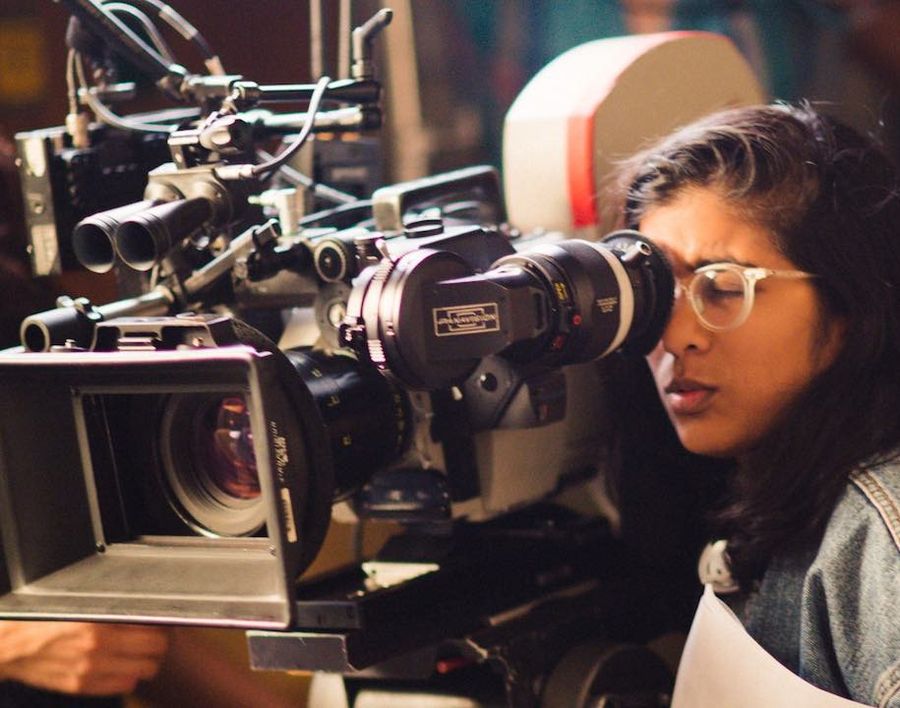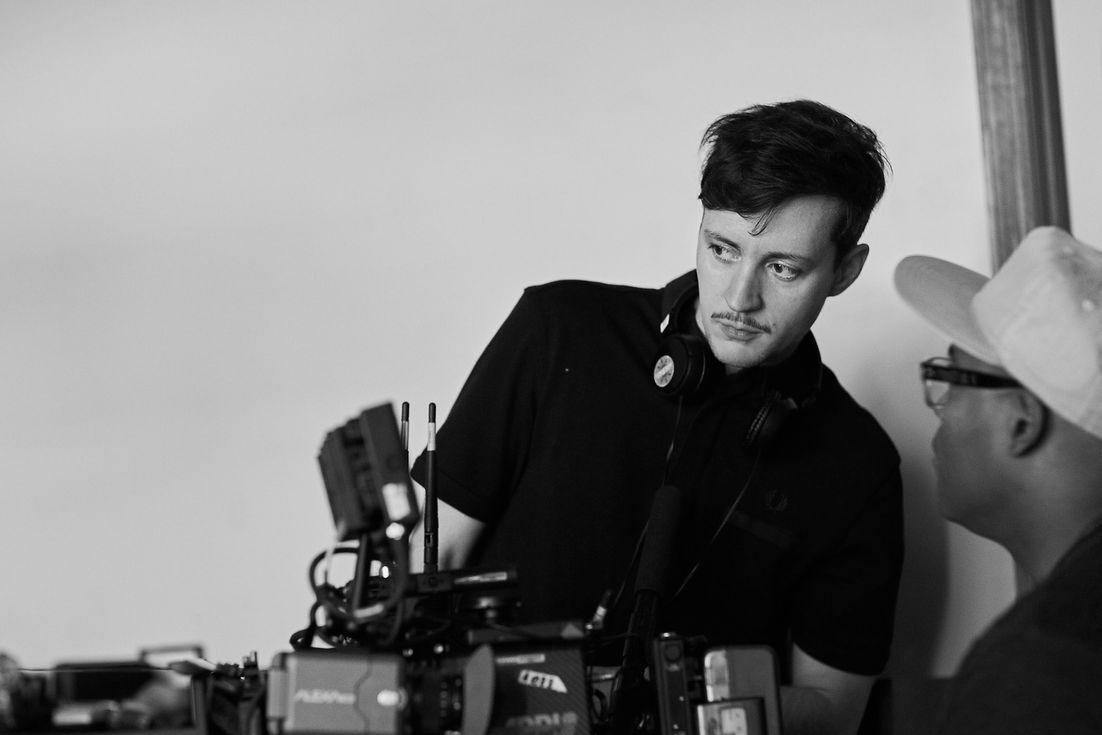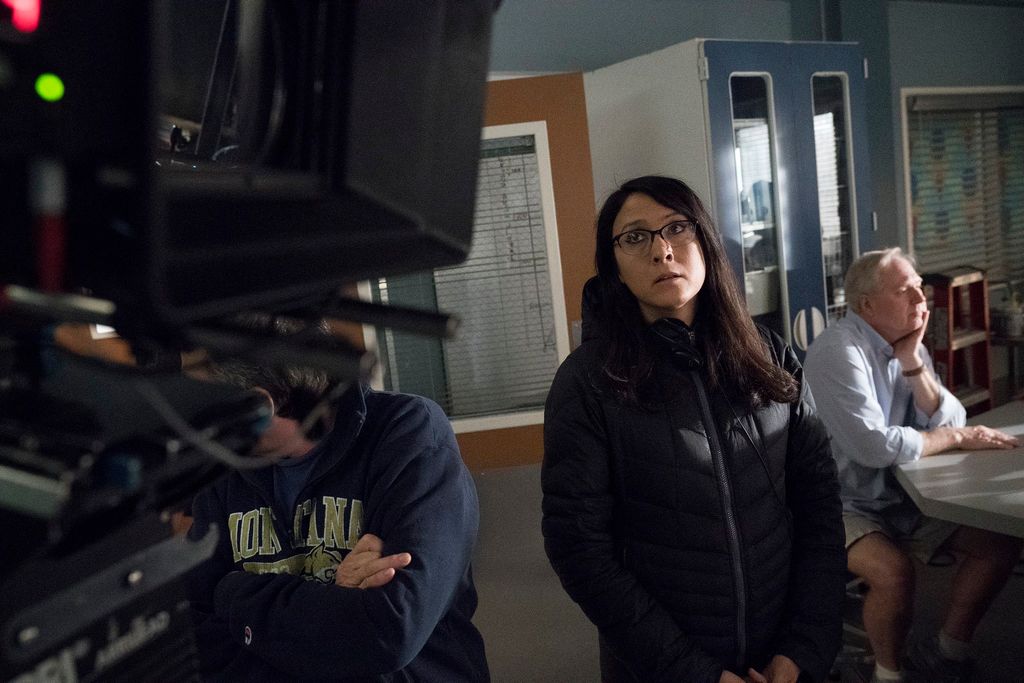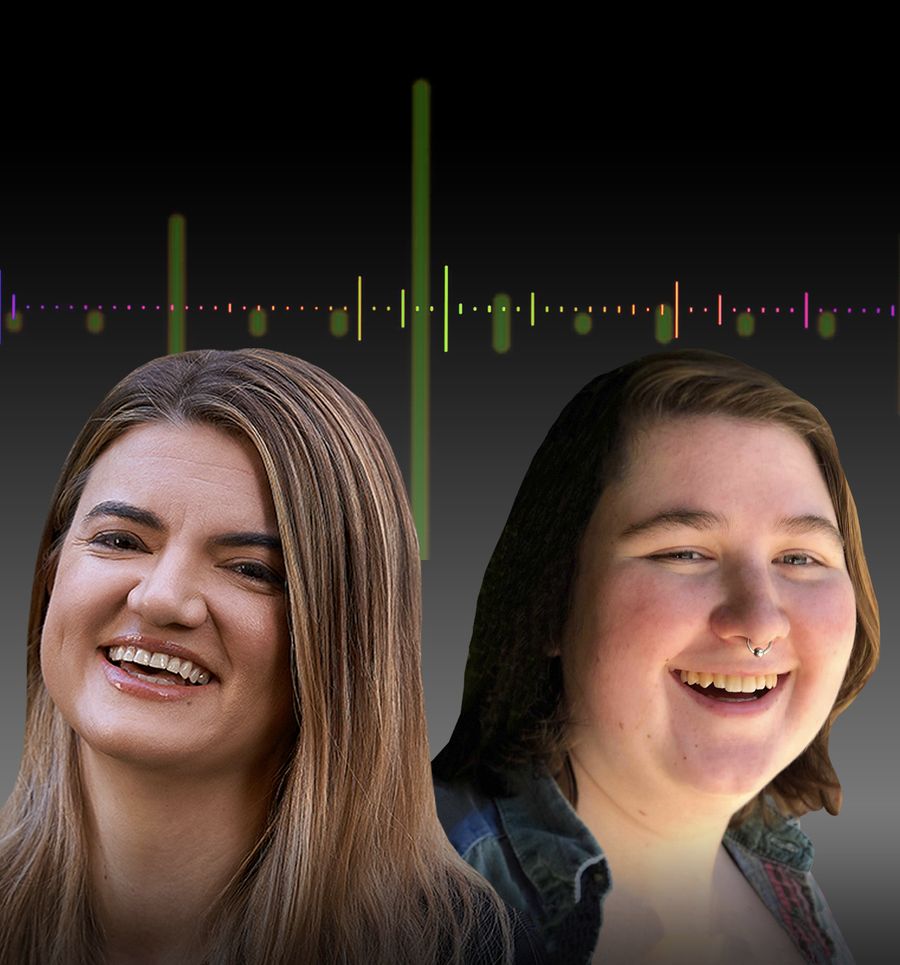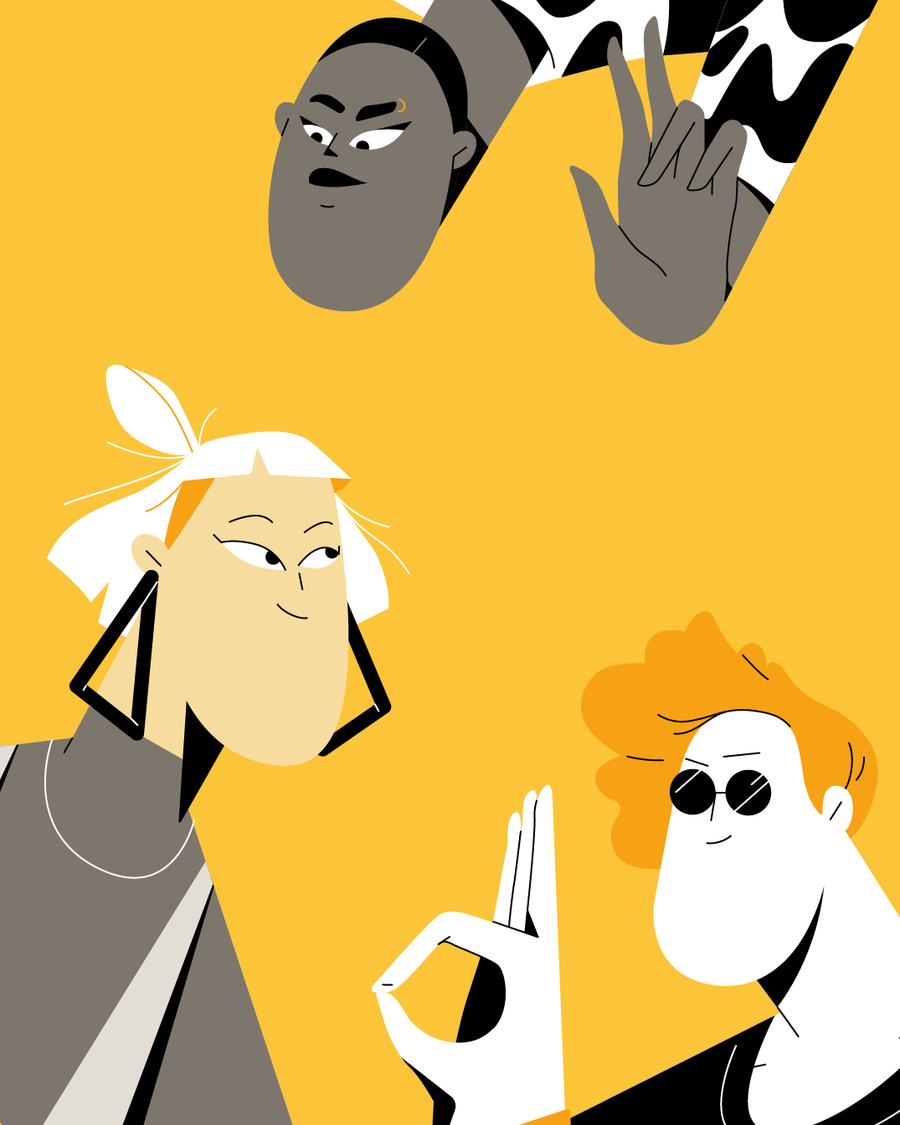The Turning is a modern adaptation of The Turn of the Screw, a ghost story that has haunted generations for over a century.
Behind every turn and twist of the film is a visionary director: Floria Sigismondi. The daughter of two Italian immigrant opera singers, Floria quickly became in tune with her artistic side and set out on a mission to immerse herself in art of all forms. In this episode of the FREE THE WORK podcast, Floria sits down with Alma Har'el to discuss her journey as an artist and her experiences with reviving a classic horror story for Amblin.
You can listen to this episode by clicking the play button above, or you can tune in through Spotify and Soundcloud. Enjoy!
Introduction: What's up world? Welcome to the Free The Work podcast. Free The Work as a talent discovery platform that uplifts underrepresented creators and connects them to those who hire in film, TV, and advertising. And now all respectable organizations in this age of human history, we have a podcast. Come kick back as we chat with some of today's most influential creatives. Consider this the film school that you never have to pay student loans for and the creative guidance that your horoscope could never give you. Today's episode features a conversation between Free to Work founder Alma Harrell and acclaimed artist, photographer and director Floria Sigismondi who's out with her latest horror film, The Turning. Based on Henry James's chilling classic, The Turn of the Screw, The Turning stars, Mackenzie Davis, Finn Wolfhard and Brooklynn Prince. Listen, as the two film makers discuss the making of the movie and explore Floria story childhood and equally legendary career. We hope you enjoy and thanks for listening.
Alma Har'el: Hey everyone. We're here in our Free The Work podcast and today I'm so honored to have with me a director much more than a director. I should call you just an artist and a creator Floria Sigismondi who I told you this when we launched Free The Work, that when I was back in Tel Aviv editing, I remember somebody who was working with me over there. I was talking to him about wanting to be a director and he said, "Well, if there's one woman there, director, you have to know about it's Floria Sigismondi, and he kind of came and showed me at the time you were doing the music videos for David Bowie. That also included sculptures that you make with projections and just totally blew my mind. So I should say that to anybody that doesn't know, Floria is a world renowned creator of film, music videos, branded content, photographs. She does art, she does installations, she's just everything she touches has a really therial and mysterious and haunting and whimsical, grotesque sometimes, profound aesthetic, and now today you're with us because you have a new film coming out. Tell us a little bit about the film and what it's called. It kind of relies on a lot of your strengths and your visual strengths, but it's not necessarily something you've done before because it's a horror film. So more than that. So tell us a little bit about it.
Floria Sigismondi: Well, first of all, thank you Alma for having me. It's good to be here and finally chat. Well, the film is through Amblin Universal and I was first approached with-
AH: Which is the company of Steven Spielberg too. Any of our listeners that don't know.
FS: And when I was approached with the possibility of doing a feature, it was one of my favorite books, The Turn of the Screw. And what I loved about it, what drew me to the project is, first of all it survived over 100 years. People have been very interested in it through the ages. And what I love about it is, when you read the book, you can read it at as a ghost story and then you could read it again and from front to cover, all of a sudden it's a story of a woman, it's a set into madness.
AH: So it's very interpretive.
FS: And that's what I loved about the book and that's why when you buy the book now, it's only 120 pages in Novella and literally it's an inch thick and it's just from the writings and people covering it and talking about the symbology and everybody's different interpretations of it. And I just thought, wow, this is a great opportunity to do something in film that's kind of hard to do. Kind of leave something a little bit open for interpretation. But that's what drew me to the project. And then just my take on it was really kind of going in in a more kind of female centric point of view. So I really made it about the protagonist point of view. Tried to create something different with it.
AH: Definitely. And I want to come back to that, but before that I wanted to talk to you about how it all started. I know your parents were both opera singers and you watched a lot of Fellini growing up. I just saw, by the way, La Strada the other day.
FS: Nice.
AH: Two days ago in bed, which was a really strange experience. So how did you sort of begin to go into directing? Was it through the art world or was it straight away into directing? What was your entry point?
FS: Well, at art college I did four years, in the last year of art college, which I took a lot of painting and design work. I grew up in Toronto. So I was two, when we moved from Italy to Toronto, Hamilton actually it's an hour outside and it's a very kind of steel, industrial kind of city.
AH: And your parents were both-
FS: They had no idea where they were going. Opera singers really, they see the world in sort of from a children's perspective. They're very kind of, everything is sort of lovely. Wonderful. So-
AH: And you spoke Italian growing up?
FS: Yes. So in my house it was little Italy and outside was Hamilton and we ate Italian, spoke Italian. I mean I was the only person who knew how to speak English, so I translated. I was speaking to collectors on the phone at five, that was my world. And opera, I just was surrounded by the tragic stories of opera. They're very tragic. And so watching the Disney channel on television, I was like, what's wrong with you people? This is not life. So it was big drama in the house. And also my dad at the time, was an atheist and my mother was going to be a nun.
AH: Wow.
FS: And so-
AH: Conflict.
FS: Yeah, the conversations at the dinner table was amazing and kind of made me sort of try to figure out where I belong-
AH: I want to see that movie.
FS: I am thinking about it.
AH: About that five year old translator immigrant.
FS: A great story especially with my father there are stories as well.
AH: So they used to argue about that?
FS: Oh yeah, daily basis. Yeah.
AH: Do you have brothers and sisters?
FS: A younger sister. Two years younger. And I always drew, so that was sort of my way into the arts but we could never afford paint or paintbrushes. So I would just look at it at the grocery store and swoon. I had no idea why I loved it. I would get little hard heart patters, just this little butterfly in my stomach that I needed to do this. And eventually my father gave singing lessons to an artist, a mosaic artist, and he would give us really pro art lessons at home. Very, very young. So I was just in heaven, doing that. But then and somewhat I knew I wanted to go to art college. When I went to art college, the last year, I just thought, well, take a photography course.
FS: And that was it. I never went to class. I was like, "I'm in the studio shooting, just leave me alone." And I never went and I just shot and shot and shot. And for me it was a way into the world, because painting kind of, you're still very insular and you're in your mind and it keeps you very isolated. Right. And all of a sudden I had to talk to people. So exciting, I got to interact with people and it was a little hard trying to figure out, because I already had a style with painting. And painting, to make things whimsical or weird or whatever, doesn't cost you anything, you just paint it. And all of a sudden I was doing things and the business side starts to get you knocks on the door.
AH: Yeah, that starts to get in the way.
FS: But I knew, I had sort of a look that I wanted to translate. So I remember finally getting that very first roll of film I got developed, it was blank and I was horrified. I was like, "Oh my God, nothing turned out and I just did a big shoot." And then the first four pictures that you just wind up your camera, just those whatever garbage pictures. There was something, there was something. It was really bright and very colorful. And I went, this is it. So I spent the next whatever, six months trying to figure out what that was and what I did. And then I put it in RAW development, I did all this stuff and I finally found sort of the thing that made photography less about documenting something and more about creating for me.
AH: We don't talk a lot enough about mistakes, what we call mistakes about how much they inform what we do.
FS: Yeah. Well because they're happy accidents.
AH: Happy accidents and just call them mistakes or failures. But actually there's so much whimsy and so much, I guess life just reaching in and guiding you somewhere.
FS: That's where I get my energy from. I get my energy from, you're on set, that's it. We're all looking this way and all of a sudden something magical is right there. And how do you kind of get everybody to focus on that because you've got to grab it and if you don't grab it, we all know it's gone. It's gone.
AH: It's gone.
FS: It's gone. And so that's what the thing about painting that I love because I'm constantly utilizing or exercising that muscle between something that doesn't exist. It's just an idea, to something out in the real world without talking to anyone. And it's just knowing when it's done, knowing what color to choose. And when we're on set, everybody's looking at us. And how do you access that point that you can make that is a much more personal experience, rather than getting lost in everybody's thoughts, which I remember the first day I walked on set I could hear everybody, that kind of-
AH: You're an impasse? you're one of those people that feel everybody?
FS: I don't anymore. I kind of learned to kind of shut that off, but I could hear absolutely everybody, everybody. And maybe the little bit of that comes from also not knowing my place because I never went to film school. I just knew that I took a lot of photographs as a series and thought, oh I can maybe do that. I love Fellini. And I was always wondering what was it like behind the camera. But that's it. I wasn't schooled for that. But I spent a lot of time in lighting my own images and framing up my own images. And so I had to learn everything on set. So some of it comes from that.
AH: And from the finding herself like that into photography, was music videos the next step in terms of moving into a moving image?
FS: Yes. A friend of mine who I knew just from the clubs and stuff, he owned a music video and commercials company thought, okay, why don't you come in and we'll co-direct something. And I did that and I went, "Oh God, this is fun." But it didn't turn out like I wanted it to turn out. So it was like, wow, I have to now learn to communicate with people, really learned to talk to people about my ideas and show references, even if it's a tiny thing. Not like I'm going to copy this, but there's color in the corner and there's the feeling in the light or something. And just to start sharing sort of how I saw the world. And eventually I got there.
AH: Does the minute that you realize as a filmmaker, especially if you didn't go to film school and they didn't drill into you all this idea of references, storyboards, references, storyboards. But there's just that moment where you kind of realize that there are things you see that you assume everybody's seeing.
FS: You seeing. That is such a big part of it.
AH: And you just realize sometimes you can talk with somebody for a long time about what a set would look like or feeling you're trying to achieve it in your first few times that you've come and you realize it's maybe not at all that and you think, what didn't I communicate? I saw it as a large room and them over there and it's dark and I didn't think this would be here. And it's not that purple. And then you just realize how detailed you need to be in order to really-
FS: Because everybody's interpretation of it's very different.
AH: Completely different. And also we kind of really see things in our heads sometimes in the same way that we dream at night. And you wake up in the morning and tell a dream to somebody, but they really don't see any of it and they don't really know the feeling of it. So in a way, I've always feel like it's pretty similar, right? You kind of have to really communicate with a production designer or a costume designer, things that you take for granted that they know.
FS: Yeah. And as a photographer, I was doing everything. I didn't have an assistant, I was moving lights, I was printing. I'd go through a box of 50 sheets to get one print perfect and I'd be dodging and burning. I mean I didn't have to talk to anybody.
AH: And also your so specific. I mean, you are really one of those people that builds worlds. You're a world builder, so it's not like, oh, I need a room and I'm shooting in an office.
FS: Yeah. Yeah.
AH: You know what I mean? It can get pretty abstract and surreal. So that's even harder always to find partners in crime who see the world a little differently.
FS: Yeah. Because I'd always say to people, I think real life is boring and the reason why I create is to go to those places, to be able to live in them and sit in them for a bit.
AH: Do you believe they exist somewhere?
FS: I do. I do believe in alternate dimensions. I also do believe in, we go somewhere when we dream and I think they can be very real. Whether we're going there to release stress or whether we're going there to travel, maybe and experience for things and bring them back into this world when we wake. But things like that we have to brush our teeth every day and do the dishes is kind of boring. As a child, I was like, what do you mean I did it? Can't that equal out forever? No.
AH: Then I saw your David Bowie videos, bless his soul. I remember those sculptures that had those projections on the faces, it was unforgettable. How did that happen?
FS: First of all, the projection was from Tony Oursler and he had worked with him already on a couple of installations, David Bowie and Tony. And so-
AH: You had your own sculptures too, yes?
FS: Yes, yes, yes, yes. There are a couple of shows that I put together of installations and sculptures but-
AH: And they were in the video too, in some of the videos?
FS: Well, what had happened is-
AH: Am I confusing it?
FS: No, no is he does the projections, but I wanted it to be part of a different world. So what we did is we got inside to the taxidermy animals. So they're just foam and I wanted to create a sculpture with that And then we used to Tony Oursler sort of the-
AH: Yeah, that's what I mean. So they have shapes-
FS: They have shapes, and then we put egg heads on them instead of animal heads.
AH: Yeah, that's what I meant.
FS: And I still have those. I saved those. Yeah.
AH: Yeah, they really stayed with me for a long time and I would see afterwards versions of it. Always seemed to me like it was the first time I saw it in that kind of form.
FS: Yeah. Well and it's funny because-
AH: The shape shifting, it was kind of haunting in a way.
FS: In those days too, I didn't meditate. I didn't know I was meditating, but what I was doing was meditating. But what I was doing on a practical way, was just putting myself through sleep deprivation. And so I'd be really, really tired, really tired. I can't come up with an idea but I got to come up with it tonight. And I would just lay there and I was so deliriously tired that when I closed my eyes I would just have this rush of images, but I wasn't sleep yet. So I was able to get up, write it down and then go back. And now I know what I was doing, it's meditation. And that's what I do now is transcendental meditation. But it's getting you in that gap. Getting that gap and then being able to wake up and kind of remembering and feeling. Because that's a place you can go to, where dreams you can forget. That's a place you can go to where you see the hairs on an arm, you see details. But not everything comes with details.
AH: I fish over there too.
FS: Do you? Yeah, of course you do.
AH: Hell yeah.
FS: Yeah I can see it with the chicken at the end.
AH: By the way though, it's actually something that I have to credit developing that with David Lowery who also is an amazing director. I don't know if you know him. Did you see A Ghost Story?
FS: Yes. No, I know of the movie.
AH: I think you would really like it. He directed that and wrote it. So you went into these music videos worlds and did you get into commercials after that? Or what came first?
FS: Yeah music videos came first, then I started to do some commercials and then, you do too many of them and then you get creatively unhappy. And then I'd go into this like, what the hell am I doing? And then I would go and do a bunch of music videos and then it'd be great. Fantastic. I need to eat and then I would do a commercial. So it kind of would bounce around and now it's a little bit more even. And now I do make sure I do some low budget music videos, because I think it's very important to exercise a part that you only have when you have no money. There's something about, okay, I don't have three weeks prep, I can't really imagine this whole thing. I'm going to go in with three ideas, a great location, very simple, look at it like a photo shoot and then all of a sudden you're jamming on set, which is so fun and I don't do that on commercials. So it's a different kind of thing and I just want to keep those experiences fun. And the thing about if I had only done features, you always dabble in commercials and other things too. We're always on set. Feature film directors are on set two years, maybe five years. And we're always figuring out what we like, what we don't, what feels good. The feeling when you know you have something and the feeling where you just need to push it a little bit more. Those are all things that we take for granted, but that's constantly happening when you're doing a commercial or a music video. It helps, I think the feature film.
AH: Yeah. And some of the commercials you make though, even though they're maybe not as jazzy in how you make them, but there's something about your sense of fashion that is so creative. I mean, even now, just looking at you, every little detail is just telling a story. And I feel like you've really managed to kind of weave that into your commercial work, right?
FS: Yeah-
AH: I can see a commercial and I know it's you before it even starts. Oh, flora did that. That's a thing to have such a distinct-
FS: Yeah, I'm interested in all of it. And I think you can use from the music to a haircut to what somebody is wearing, all as part of the visual world and the atmosphere. And I really got it from my mom because my mother was this very talented seamstress. I mean, she won't go anywhere near it now, but-
AH: Why?
FS: Because she thinks that you can get something for $3 and why bother making anything when you [inaudible 00:18:55], but…
AH: Is she angry about that though?
FS: No, no, she, no, she's was quite relieved.
AH: She's happy.
FS: But literally we'd watch the Sonny and Cher show and the next week she would have Cher's dress.
AH: Wow.
FS: And then they would take the bus to go to the opera because that's the money that they had to go to the opera. They'd be decked out from head to toe or she would make me… I don't know if you remember this band called the Bay City Rollers-
AH: I don't.
FS: … from the 70s? Okay. Well, they would wear these one piece knickers and they'd be all plaid. And my mother would be like from a Sears catalog-
AH: You had the best childhood photos.
FS: Oh yeah. Crazy. She'd be like, "We're making this." I'm like, "Okay." And then I'd almost get killed at school because I looked so different. But in the end, that's what makes you who you are because then as you grow up, you're just like, whatever. If it's a muggy day here, I wear really bright colors. It's just one of the things that I use to make me feel a certain way.
AH: Yeah. And you can see the new movie too, The Turning. I mean it's not the usual looking film in terms of how people are dressed and look like. And there's kind of like a sense of fashion even when it is worked into the characters. But I can see you there.
FS: Yeah, because what I did is, I did a lot of sketches and I wanted Kate to be long and tall but to have army boots and long slip dresses and call a little bit to the Victorian era because that's when The Novella was written, but still very '90s, but not modern day, because I didn't want to put the film in today because you've got technology-
AH: You got cell phones everywhere.
FS: Cell phones, the ruin of everything.
AH: It's crazy, right? It almost feels that if you're making a film about now, you immediately have to make a statement about technology because it's become such a big part of communication.
FS: Yeah.
AH: So it's kind of a little hard to be timeless.
FS: Yeah.
AH: In the past you could have made a film that's being made in the presence and still aspire to be timeless, now it's almost impossible.
FS: Yeah. And maybe subconsciously, because I want to get rid of technology, but I really wanted to put it in an era where there was none of that. I wanted to isolate her in this big estate. And so that's what I chose to do. And it kind of works for that kind of film, I think, unless the ghost is in the phone, then that would excite me if it's like, oh, if he got this weird text from this other, then that would be okay, let's work with that. But it wasn't about that. So I set it in the 90s and that era is very kind of rebellious and has a bit of an edge to it and angsty and that sort of Finn Wolfhard's character in the movie. He's kind of like a live wire. So I thought that that was the thing to do.
AH: And they say that two things that are hardest to do. I always hear it as like working with animals and children.
FS: Yes.
AH: I have found that it's the easiest thing to work with children. I feel children are so open, so they're living in their imagination. So when you find a kid that like Brooklynn Prince who's just a miracle on earth.
FS: Yes. She's a miracle.
AH: So tell me a little. You're a fan of this magical creature.
FS: Okay, so what happened is I had my eye on her. She's six years old and I was like, okay, that's younger-
AH: Where did you see her in, Florida Project?
FS: Florida Project.
AH: In Sean Baker's beautiful film?
FS: Beautiful film. And I was like, well she's six years old. I don't know if she's too young. We'd sort of upped the age thinking that, okay, maybe I'll work with a nine year old. And then I got the opportunity, I got a phone call from the New York times-
AH: How old is she now?
FS: She's actually nine now.
AH: Now she's nine?
FS: And she was six in the Florida Project.
AH: Yes she was, yeah.
FS: And then New York Times came to me and said, "Would you like to do the best performance issue? Do the films and the photography. And they slated who it was and Brooklynn Prince was there for the Florida Project. She was being celebrated for that. And I went, I'm going to do this because it's going to be easier than for me to have her on a casting session. Actually get down and dirty and do something with her. It was wonderful. I'd only worked for her for three hours. We had to shoot a film and the photography and she had already created a backstory for this little demon child and I was like going, "This is not scaring you? And she's like, "No. She got killed on her way home from school and the ghost followed her home." And I was like, "Whoa, you've got a whole world in your head that's just so imaginative.
AH: And we should say that the Brooklynn Prince herself, this nine year old has directors a film.
FS: And she's like that on set. She's constantly giving you ideas. She's constantly thinking. When the actor that means something to her characters not even in the room, she's talking about how she does misses them and how she's sad and how it makes her new relationship with Kate, little dear Fred. Does she trust… She's constantly, constantly thinking about those things and it's amazing.
AH: Wow.
FS: Yeah. We actually wrote a little scene from one of her ideas. It was amazing.
AH: Really?
FS: Yeah. Because she came in and she went, "Because Jessa left in the middle of the night, I think I would go check up on Kate and make sure she's still there." And I went, "Brilliant." Because it doesn't take anything to do that scene. She's there in the morning, kind of going, "You're still here?" And so boom, we did it and moved out of that. That's again, one of those magical moments. You just have to go, because there's something there that if you don't act, it's gone.
AH: Wow. So when is The Turning, when are we going to see it?
FS: January 24th.
AH: January 24th and the soundtrack is with Lawrence.
FS: Yes.
AH: Lawrence Rothman, who we had the honor of having him here with us and you when we launched Free To Work at the event, how was it to work together?
FS: Oh, we had worked, obviously our working relationship spans many, many, many years. And he had scored The Runaways for me, but it was a completely different kind of experience. I had thrown all kinds of music to it. And because it was about the runaways, it was so guitar based, I went, oh God, the score has to be guitar. So we did something really beautiful and sometimes painful sounding and a little sad sounding for me. So which was fantastic. And this one was very different. And this one I thought, okay so if I put needle drop in it, like a whole '90s, people are going to come in loaded with their memories of that era. And I didn't want that. I wanted to really create, it's a world that I still want to set in the '90s. So he kind of came in and curated this beautiful list of artists from Alex Glass and Mitski and we have Soccer Mommy.
AH: Kind of brought them into this world.
FS: Yes. And he wrote a lot of the songs and the lyrics now have meaning. So the lyrics talk to anything about anywhere from the atmosphere of the movie to sort of an imaginary Kate's diary is how he took it upon himself to kind of take that as a window. But it's great when I watched the film because it sort of is another layer to creating a unique world that was very different than if I had done it the other way. And it was such a fun experience I think I'll always do it this way from now on.
AH: Well thank you so much. I really hope that I get to see one day this movie about the little immigrant that translates for her parents who are opera singers. I feel like it's going to be something, whether it would be a drama or a horror film, I'll watch it right away.
FS: Yeah right. Thank you. Thank you for having me here.
AH: Thank you for supporting Free To Work.
FS: And I was going to say thank you on behalf of women and people of diverse backgrounds of all kinds for what you're doing is absolutely creating community is a thing that's lacking and it definitely was lacking when I first started, so thank you.
AH: Thank you. Love you.
FS: Love you. Bye.
AH: Bye.
Thanks for listening. Be sure to check out The Turning in theaters everywhere on January 24th. For more of everything Free To Work, go to www.freetowork.com.
Floria Sigismondi
Floria Sigismondi brings her singular artistry to the advertising world, lending an immediacy and edge to the world’s most recognizable brands. Her award-winning work across commercials, music video, and photography—including two published monographs—continue to reinforce these genres’ relevance as art forms. With her trademark cinematic style and impeccable design sense, Sigismondi has re-imagined such brands as Samsung, Absolut, Target, MAC Cosmetics, Motorola, and CoverGirl, much as her iconic music videos helped invent and re-invent the personas of artists like David Bowie, Justin Timberlake, Pink, Katy Perry, Christina Aguilera and Marilyn Manson. Both the 2014 International Cristal Festival and the World Luxury Awards honored Sigismondi’s fragrance campaign (film and print) for Thierry Mugler’s Alien.
The daughter of Italian opera singers who emigrated to Canada when she was young, Sigismondi was raised in an exceedingly artistic environment. She studied painting, illustration, and photography at Ontario College of Art, leading to a career in fashion photography, which introduced her otherworldly take on modern beauty. Bringing her audacious, painterly imagery to music video, Sigismondi has become one of the most acclaimed directors in the field’s history.
In 2013, her video for Justin Timberlake’s “Mirrors” swept video awards globally, including the MTV Video Music Award for Video of the Year. Spectacle, the first museum exhibition to celebrate the art and history of the music video, showcased Sigismondi’s enormous influence, while her video for Marilyn Manson’s “The Beautiful People” earned a permanent spot in New York’s Museum of Modern Art. In 2010, Sigismondi made her feature film debut with The Runaways, a coming-of-age biographical film she wrote and directed about the 1970’s all-girl rock band, starring Kristen Stewart and Dakota Fanning. In both her commercial and creative endeavors, Sigismondi gives innovative form to the subconscious, exploring the space where the physical and psychological intersect. Her flawlessly executed worlds of fantasy and aspiration recast popular culture from a perspective of hope and beauty, guiding its visual and conceptual evolution.
